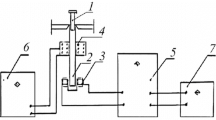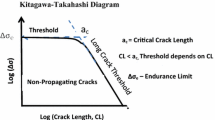Abstract
Test results for the growth of a small corner crack under cyclic loading are presented. The number of grains that are crossed by the crack front ranges from about three to ten during the crack advance. Crack path profile measurements on the adjacent corner faces are presented. Also, a microscopic examination of the crack path morphology of a polished and etched surface that is adjacent to the corner reveals the presence of complex branching mechanisms, and localized regions of intensive damage. Examination of sub-surfaces reveals that though branching and localized damage are present, they diminish with increasing depth of the subsurface. It is concluded that during early growth, the crack surface deviates substantially from an idealized planar surface model, and that Modes I, II, and III are all operative.
Similar content being viewed by others
References
Carlson, R.L., Steadman, D.L., Dancila, D.S.and Kardomateas, G.A. (1996).An investigation of the growth of small corner cracks from small flaws in aluminum 6061-T651. Proc.Sixth International Fatigue Congress, (Edited by G. Lütjering and H. Nowack), 289-294.
Carlson, R.L., Steadman, D.L., Dancila, D.S.and Kardomateas, G.A. (1997). Fatigue growth of small corner cracks in aluminum 6061-T651. International Journal of Fatigue 19, 119-125.
Carlson, R.L., Steadman, D.L. Dancila, D.S.and Kardomateas, G.A. (1998). An experimental investigation of the growth of small corner fatigue cracks in aluminum 6061-T651. Fatigue and Fracture of Engineering Materials and Structures 21, 403-409.
Carlson, R.L.and Halliday, M.D. (1998). A Consideration of Scatter in Small Fatigue Crack Growth. Low Cycle Fatigue and Elasto-Plastic Behaviour of Materials (Edited by K.T. Rie and P.D. Portella), Elsevier, 511-516.
Cox, B.N.and Morris, W.L. (1988). Monte Carlo simulations of the growth of small fatigue cracks. Engineering Fracture Mechanics 31, 591-610.
Edwards, P.R.and Newman Jr, J.C. (1990). An AGARD supplemental test program on the behavior of short cracks under constant amplitude and aircraft spectrum loading. Short Crack Growth in Various Aircraft Materials. AGARD REPORT 767.
Leis, B.N., Hopper, A.T., Ahmad, J., Brock, D.and Kanninen, M.F. (1986). Critical review of the fatigue growth of short cracks. Engineering Fracture Mechanics 23, 883-898.
Liaw, P.K. and Logsdon, W.A. (1985). Crack closure: an explanation for small fatigue crack growth behavior. Engineering Fracture Mechanics 22, 115-121.
Murakami, Y.and Nemat-Nasser, S. (1983). Growth and stability of interacting flaws of arbitrary shape. Engineering Fracture Mechanics 17, 193-210.
Petit, J. (1992). Modeling of Intrinsic Fatigue Crack Propagation, Theoretical Concepts and Numerical Analysis of Fatigue (Edited by A.F. Blom and C.J. Beevers), Engineering Materials Advisory Services LTD., Warley, West Midlands, UK, 131-152.
Schijve, J. (1994). Fatigue predictions and scatter. Fatigue and Fracture of Engineering Materials and Structures 17, 381-396.
Smith, A.R. (1984). Plants, fractals and formal languages. Computer Graphics 18, 1-10.
Steadman, D.L., Carlson, R.L.and Kardomateas, G. A. (1998). Expert system model of small crack growth. Proc. 39th AIAA/ASME/AHS/ASC Structures and Materials Conf. Part 4, 3003-3013.
Suresh, S. (1991). Fatigue of Materials, Cambridge University Press, 182-189.
Torng, T.Y. and McClung, R.C. (1994). Probabilistic fatigue life prediction methods for small and large fatigue cracks. Proc. 35th SDM Conference, AIAA, 1514-1525.
Yang, J.N., Hsi, W.H. and Manning, S.D. (1985). Stochastic Crack Propagation with Applications to Durability and Damage Tolerance Analysis, AFWAL-TR-85-3062.
Author information
Authors and Affiliations
Rights and permissions
About this article
Cite this article
Carlson, R., Steadman, D. & Kardomaters, G. An examination of small fatigue crack morphology. International Journal of Fracture 108, 63–72 (2001). https://doi.org/10.1023/A:1007667017241
Issue Date:
DOI: https://doi.org/10.1023/A:1007667017241




